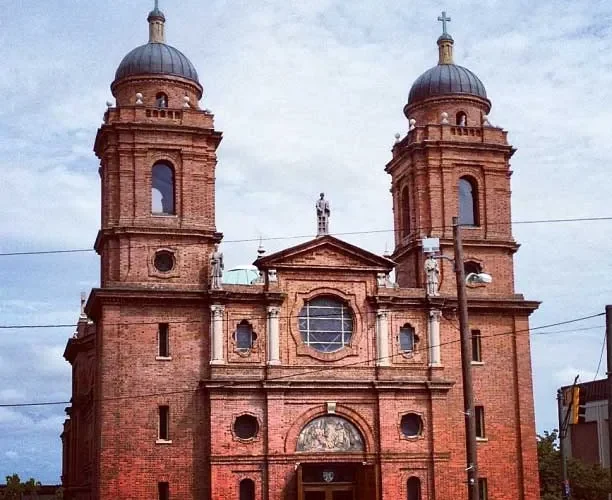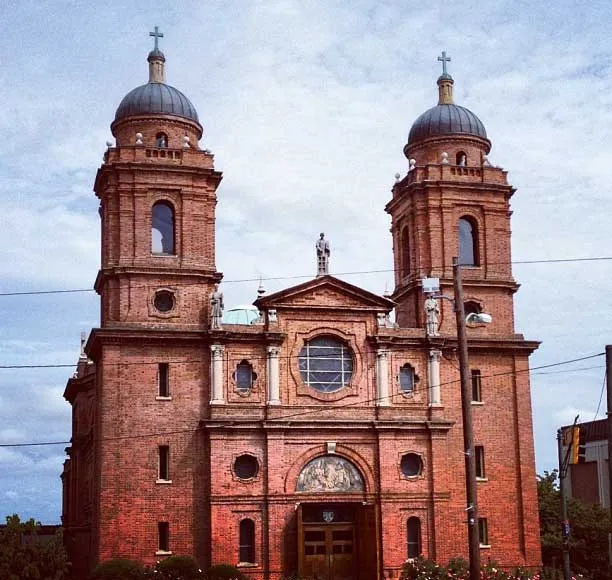
Introduction
The Minor Basilica of St. Lawrence the Deacon & Martyr is a Minor Basilica of the Roman Catholic Church in downtown Asheville, North Carolina, United States. The church was designed and built in 1905 by Spanish architect Rafael Guastavino along with his fellow architect Richard Sharpe Smith the same architects responsible for the Biltmore House. Completed in 1909, it was immediately evident that the Basilica of Saint Lawrence was something extraordinary. It has the largest freestanding elliptical dome in the country.
Pope John Paul II elevated the status of the church to Minor Basilica in 1993. It is a parish church, located within the Diocese of Charlotte. It is on the National Register of Historic Places. It is the only basilica in western North Carolina. Its dome has a span of 58 by 82 feet (18 by 25 m) and is reputed to be the largest, freestanding, elliptical dome in North America. Except for the foundation and brick walls, the architectural style is Catalan, with the main example being the stairs behind the altar. It is located in the Downtown Asheville Historic District.
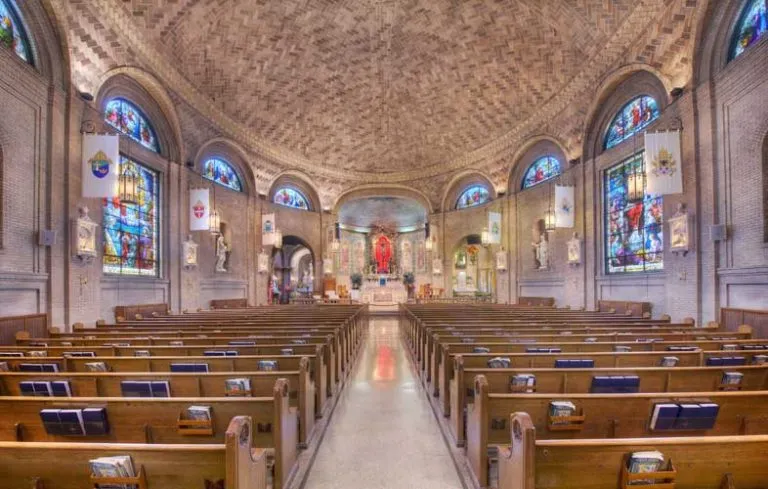
History of Basilica of Saint Lawrence Asheville
Built in the early twentieth century, this church is an architectural marvel. There are no metal or wooden beams in the structure. The movement and in good shape are the German-made stained glass windows. It’s a must-see, definitely. Superb building with such a magnificent history. Very clean and friendly. Peaceful terrain and a place that everyone can enjoy. A great peaceful place for a relaxing time. In comparison to many basilicas others have visited, this is a small basilica. The tour is free of charge. It’s always open when you like to pray.
The House is over one hundred years old. The outside is brick-covered. The cathedral is elliptical. Very lovely cupola. The dome is covered with tiles on the inside. Nice pattern. With good pattern. The middle is a skylight, which makes the cathedral tiny. During the weekdays we are visiting the front is close. However, in the dome, you can use the side door. At the top of the main entrance is the organ pipe. Next to it is stain glass. There are two smaller shrines near the main sanctuary. On the left shrine, candle light may be offered. On every day, Mass is available. Spanish Mass only. Only Saturday’s confession. It’s basilica, it’s not a common church.
Basically, there are Vatican requirements and everything must work. The Pope would enter and all of us know exactly how (in addition to other things) to plan for a great mass. It has the largest elliptical cathedral. Since immigrating from Italy, Guastavino designed this church himself. He made the bricks himself (from what it told me) and donated just about everything. He bought some of the church’s major pieces, one of whom was a wooden crucifix from the 17th century. He was in the church in fact buried; please check the crypt on the left side of the altar (you can open the door). Regardless of your religious background, the Basilique is a beautiful building work. A “basilica” from outside may appear a bit underwhelming, but within the dome and stained glass artwork are incredible and definitely worth a visit.
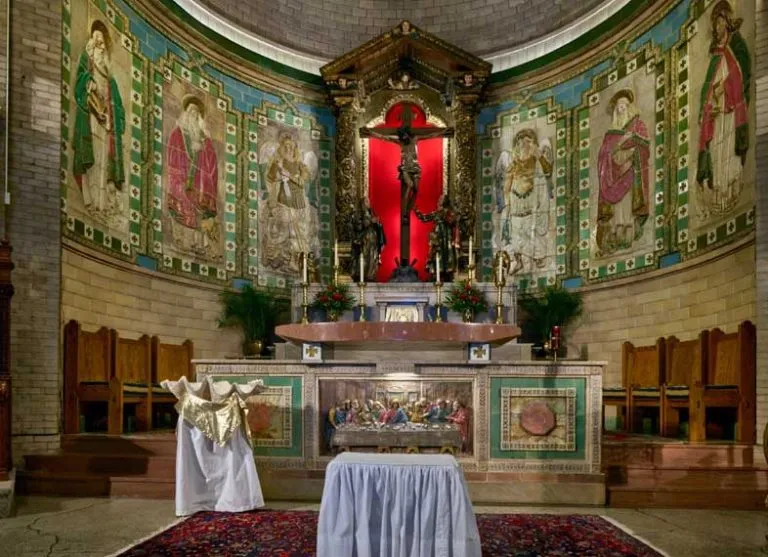
Architecture
Architectural Styles: Beaux-Arts Architecture, Spanish Baroque Architecture.
Interior
The Basilica of Saint Lawrence Asheville entering the vestibule, which is separated from the church proper by screens of leather and stained glass, one notes the solidity of the structure; the very steps to the organ left are without wood or nails. The vestibule window to the right is Bishop Haid’s coat of arms; the one to the left is the coat of arms of Pope St. Pius X.
From the foot of the main aisle, inside the church proper, one can realize the beauty of the ellipse and the wonder of the dome. It has a clear span of 58 x 82 feet and is reputed to be the largest freestanding elliptical dome in North America.
The four statues in the wall niches are from the Daprato Statuary Company, Italy. On the left, St. Cecilia and St. Peter; on the right, St. Rose of Lima and St. Patrick.
Exterior
The style, chosen by the architect, is Spanish Renaissance. The central figure on the main facade is that of our patron, the 3rd century archdeacon, St. Lawrence, holding in one hand a palm frond and in the other a gridiron, the instrument of his torture. On the left of St. Lawrence is the first martyr, St. Stephen, holding a stone, the method of his martyrdom. He also holds a palm. (In art, a subject holding a palm has been martyred for the Christian faith.) On the right stands St. Aloysius Gonzaga, a 16th century Jesuit seminarian from Spain who perished in the plague.
The lunette over the main entrance is made of polychrome terra cotta and represents Christ giving the keys of the kingdom to St. Peter and appointing him head of the Church. Immediately below this lunette is a stained glass window displaying the Coat of Arms of the Basilica of St. Lawrence.
The building is remarkable, there are no beams of wood or steel in the entire structure. All walls, floors, ceilings and pillars are of tile or other similar materials. The roof is of tile with a copper covering.
The massive stone foundation, of North Carolina granite, and the solid brick superstructure give silent testimony to the architect’s desire to build an edifice that would endure for generations.
Stained Glass Windows
The Basilica is known for its many elaborate stained glass windows, many of which were made in Munich, Germany. On the right wall of the basilica, the windows depict the Annunciation of the Blessed Virgin Mary, the Visitation of the Blessed Virgin Mary, the Nativity of Christ, the Child Christ Teaching in the Temple, and the Conversion of Saint Paul. On the left wall the windows depict the Wedding at Cana, Christ Healing the Daughter of Jairus, the Calming of the Wind and Waves, the Agony in the Garden, and the Resurrected Christ appearing to St. Mary Magdalene. The two large windows, one on the eastern wall and one on the western wall, represent Christ healing the afflicted and the Transfiguration of Christ. The large window in the organ loft portrays the Resurrection of Christ.
St. Lawrence, Deacon & Martyr (A.D.258)
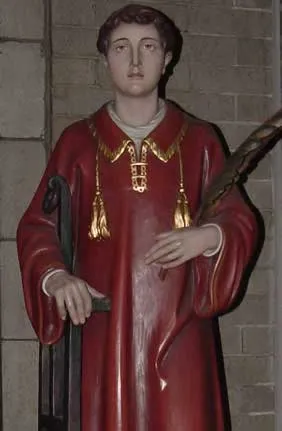
Lawrence, a deacon who served the church in the third century, was the caretaker of funds and dispenser of alms to those early Christians in need. A faithful disciple of Pope St. Sixtus, martyrdom took place three days after that of the holy Pope.
That is all that is known for certain of the life and death of St. Lawrence. The writings of St. Ambrose, the poet Prudentius and others, with details about his life and death, have been adopted by Christian tradition.
This tradition holds that Lawrence anticipating the martyrdom predicted for him by Pope St. Sixtus, gave all the money in his care to the poor and the proceeds from the sale of the sacred vessels he distributed in like fashion.
The prefect of Rome believed that Lawrence had hidden still more of the church’s treasures and he wanted to secure them for the emperor and himself. The prefect was angered when Lawrence showed him lepers, cripples, orphans, widows, the poor and the lame as the Church’s true treasures. Lawrence was condemned to a slow, painful death by the irate prefect. A large gridiron was made ready and glowing coals were put under it that Lawrence might be slowly burnt. After suffering a long time, and praying for the conversion of Rome, he died.
It is stated that his death marked the death of idolatry in Rome. Christianity spread and many miracles were worked through the Intercession of St. Lawrence, who has been one of the most venerated martyrs of the Roman Church since the fourth century.
We honor St. Lawrence, who spent himself for the poor of the Church. Thus he merited to suffer martyrdom and to ascend in joy to Jesus Christ the Lord.
Chapels
To the right and the left of the High Altar there are Two Chapels.
Chapel of Our Lady
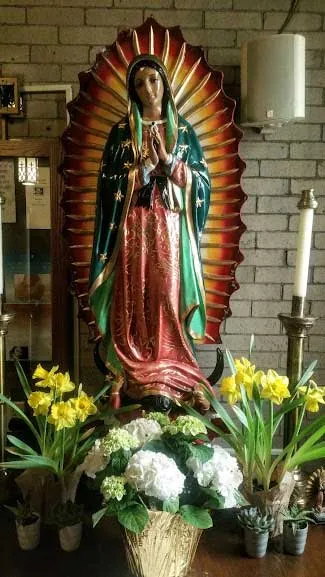
To the left of the main altar is the Chapel of Our Lady. The white marble statue depicts Our Lady of the Assumption. Inserted in the upper part of the altar is a panel entitled The Crucifixion, which is attributed to an old renowned pottery in Capo di Monte, Italy. On either side of the tabernacle are niches containing statues of the following from the extreme left.
Saints. Margaret, Lucia, Cecilia, Catherine of Alexandria, Barbara, Agnes, Agatha, Rose of Lima. Forming a frame around the altar front is a series of tiles lettered with the names of Our Lady selected from the Litany of the Blessed Virgin. In the center is a fragment of Italian marble depicting the Nativity. Arching over the altar are seven doves, which represent the seven gifts of the Holy Spirit.
The large stained glass window is St. Mary of the Sea; the small one above is St. Raphael, the archangel. The ornately carved door to the sacristy is of Spanish design and is dominated by the theme of the Good Shepard; on the scroll is the Latin, Pastor Bonus. Above the door is a 17th century painting of the Visitation. The artist is thought to be Massimo Stanzione (1585-1656).
On the walls of the chapel are icons of the Blessed Lady as: Our Lady of Czestochowa, Our Lady of Perpetual Help, Virgin Mary of Guadalupe, and the Annunciation.
At the rear of the chapel is the crypt of the architect, Signor Rafael Guastavino. The door is of lustre-glazed tiles framed in bronze. The lustre-glaze process was discovered by Rafael Guastavino, Jr. during ceramic experiments conducted at the Guastavino tile factory in Woburn, Massachusetts.
St. Joseph Chapel
The second chapel, to the right of the main altar, is the “Eucharistic Adoration Chapel”, originally named the “Chapel of St. Joseph”. The chapel is used for Eucharistic adoration and private prayer. The Holy Eucharist is displayed on the chapel’s altar before and after Mass for adoration, prayer, and meditation. The stained glass window above the altar depicts the Nativity of Christ, similar to the tile painting in the Marian chapel. The eastern wall’s window is a stained glass painting depicting the death of St. Joseph in the arms of his family: Jesus Christ and the Blessed Virgin Mary. The smaller window in the chapel depicts St. Lawrence, to whom the basilica is dedicated. The chapel’s altar and part of the apse wall are a mosaic of bits of tile assembled by Rev. Peter Marion and Rev. Patrick Marion, who were priests during the construction of the basilica.
The Statues
On the east wall there are two life size statues. Close to the altar is St. Patrick and near the choir loft is St. Rose of Lima, on whose feast day it was determined that a parish would be formed in this area. The niches on the opposite wall hold St. Cecilia, the patron of music and near the altar is St. Peter. The statues of Peter and Patrick were placed in honor of Frs. Peter and Patrick Marion, priests in residence during construction of this church.
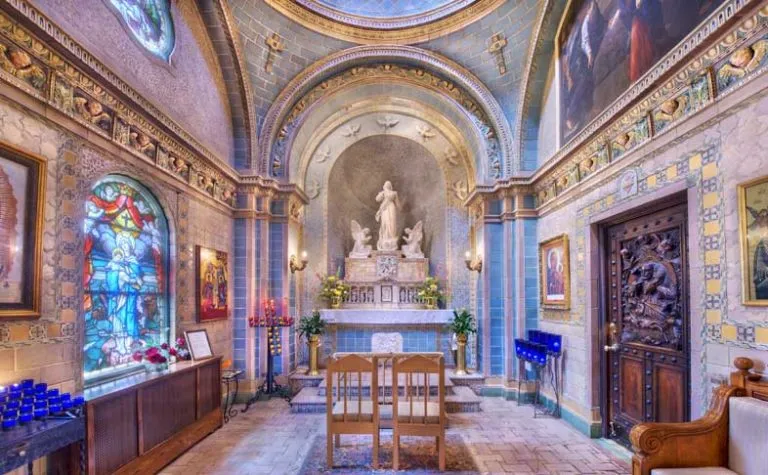
The Sanctuary & Main Altar
The area inside the communion rail is referred to as the Sanctuary. Above the main altar stands a tableau depicting the Crucifixion. From the 17th century, it is hand carved walnut showing Mary, the Mother of Christ, and John, the beloved disciple. The wall behind the altar is called a reredos. It has been executed in polychrome terra cotta and bears life size reliefs of the four evangelists, Matthew and Mark on the left; Luke and John on the right. Flanking the tableau are Michael the Archangel at the left and the Archangel Raphael at the right. The altar was originally the base of the back altar. After Vatican II it was brought forward to enable the celebrant to face the congregation. The marble altar top positioned above it was consecrated in 1968. The image on the face of the altar is made of polychrome terra cotta and depicts the Last Supper. The symbols left and right are the Alpha and Omega God, the beginning and the end of all things.
Feast Day – 10th August
Minor Basilica of Saint Lawrence, Deacon and Martyr, Asheville Annual Feast Day of Saint Lawrence will be held on 10th August.
Mass Time
Mondays & Fridays
Tuesdays, Wednesdays & Thursdays
Saturdays
Sundays
Church Visiting Time
- Mondays : 11:00 am to 12:00 (Noon)
- Tuesdays, Wednesdays & Thursdays : 11:00 am to 1:00 pm & 3:00 pm to 5:00 pm
- Fridays, Saturdays & Sundays : Closed
Other Facilities
The basilica includes a rectory for the priest, a Catholic library, and a gift shop for tourists, which are open after weekend Masses. Behind the basilica is a Mary garden, which contains a life sized, white statue of the Blessed Virgin Mary.
The Basilica Gift Shop
The Basilica Gift Shop carries a variety of religious items, such as rosaries, medals, sacred images, bibles, candles, and gifts appropriate for sacramental occasions. Open after the Vigil and Sunday Masses, the Gift Shop is typically open on Saturdays from 6:00 to 6:30 p.m., and Sundays from 10:00 to 10:30 a.m., 1:00 to 1:30 p.m. and 6:00 to 6:30 p.m.
Contact Info
Basilica of Saint Lawrence, Deacon and Martyr,
97 Haywood Street, Asheville,
North Carolina, 28801, United States
Phone No.
Tel : +1 828-252-6042
Accommodations
How to reach the Basilica
Asheville Regional Airport in Asheville, North Carolina, United States is the nearby Airport to the Basilica.
Greenville Train station in Greenville, South Carolina, United States is the nearby Train Station to the Basilica.

